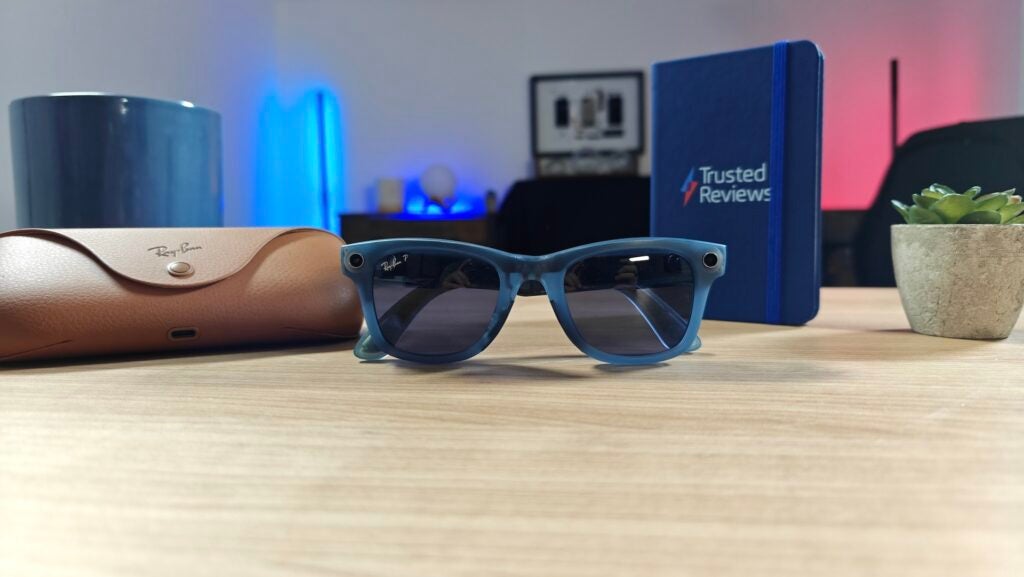As well as revealing a slew of smartphones and tablets set for the US market, TCL announced that its new high-tech smart glasses, the RayNeo X2 Lite, will be available to purchase in Q3 2024.
The question is, how do the RayNeo X2 Lite compare to the most popular smart glasses around right now, the Ray-Ban Meta Glasses?
Despite the diminutive dimensions of the X2 Lite glasses, they’re surprisingly capable. In fact, they deliver the complete smart glasses experience with built-in displays, an AI assistant and much more. On the other hand, the Ray-Ban Meta Glasses focus more on content capture and consumption with built-in cameras, speakers and the like.
We’re yet to go eyes-on with the RayNeo X2 Lite, but we have spent plenty of time with the Ray-Ban Meta Glasses. With that in mind, here’s how the RayNeo X2 Lite and Ray-Ban Meta Glasses compare on paper.
The TCL RayNeo X2 Lite are fully-fledged AR glasses
The key difference between the TCL RayNeo X2 Lite and the Ray-Ban Meta Glasses is the display tech within the former, essentially providing the fully-fledged AR glasses experience promised in every Sci-fi movie for the past 40 years.
The Ray-Ban Meta Glasses can take photos, play music and perform other handy functions like live streaming from the glasses, but they don’t sport screens for visual support.
More specifically, the X2 Lite glasses sport transparent full-colour microLED screens within each lens, and combined with 1500nit brightness, should allow you to see virtual elements in the real world, even in bright conditions.
It’s a game-changer for smart glasses, allowing for elements like on-screen navigation and translation, and that’ll likely grow once developers get their hands on the kit. Its predecessor, the RayNeo X2, has been available in China for some time and it’s proven hugely popular, suggesting this is more than a niche product.
The TCL RayNeo X2 Lite is a great example of impressive engineering and design, managing to pack all the tech needed to power the displays and AR experience within the specs while weighing a lightweight 60g. That should translate to a more comfortable wearing experience, closer to regular glasses than many smart alternatives.
But while that’s impressive, they’re not exactly the most stylish-looking specs around. They sport a uniform black finish with RayNeo logos on the front and sides, and that’s about it. It’s possible that other colour options could be in the works ahead of release later this year, but for now, it’s black or nothing.
That’s a stark difference to the stylish Ray-Ban Meta Glasses, with Meta’s smart specs massively benefiting from the Ray-Ban style and brand recognition.


The Ray-Ban Meta Glasses essentially look like a pair of classic Ray-Bans, available in either the Aviator or new Headliner styles, with several colour options for the frames – including semi-transparent options to showcase the internal tech – and plenty of colours for the lenses. You can even get your prescription fitted within the specs for added comfort.
They also come in an equally stylish leather carry case that doubles up as a portable charger for the specs, adding to the overall premium look. Essentially, style is most important to you, the Ray-Ban Meta Glasses are the best option at present.
Both can capture photos and videos
One of the strongest elements of the Ray-Ban Meta Glasses is their ability to capture 13MP photos and record POV-style videos in 1080p resolution on the fly, allowing users to capture the moment without staring at a glass rectangle. The photos and videos produced are surprisingly high quality too, with impressive video stabilisation providing a ‘floaty’ look to videos.
However, that’s something that the RayNeo X2 Lite will also be able to do via a front-facing camera. TCL has yet to confirm the specs of the camera and the resolution it’ll capture content in, but from the marketing images, we can see that it’s centrally mounted on the bridge of the glasses.
This could be a potential benefit compared to Ray-Ban’s smart specs. You see, the camera is mounted on the left corner of the Ray-Ban Meta Glasses, and that means that videos are slightly off-centre compared to what you’re seeing in the moment.
TCL’s more central placement should hopefully solve this issue, capturing whatever’s directly in front of you at all times, but we’ll have to wait and see for now.
The TCL RayNeo X2 Lite has a heavy focus on AI
The Ray-Ban Meta Glasses boast Meta Assistant functionality, allowing you to wake the glasses with a ‘Hey Meta’ and get the glasses to perform various functions.
This can range from taking photos or videos to sharing said content with friends and family through Meta-owned services like Facebook Messenger or WhatsApp, but it’s not a fully-fledged AI system like what you’d get from Amazon Alexa or Google Assistant.
The TCL RayNeo X2 Lite, on the other hand, goes all-in on AI. That’s largely down to the inclusion of Qualcomm’s dedicated Snapdragon AR1 Gen 1 platform designed specifically for smart glasses.
This allows the AI to “help you navigate the app menu and make selections” to avoid tapping the glasses all the time, and it’ll even help you avoid traffic by making “smart AI travel recommendations” based on your schedule.
It’ll also power the real-time translation tech on offer from the smart specs, in addition to the regular live captions the glasses can generate for those who are hard of hearing.
The TCL RayNeo X2 Lite glasses will go on sale later this year
TCL confirmed at CES 2024 that the RayNeo X2 Lite smart glasses are due to go on sale in Q3 2024, though pricing and specifics on where exactly it’ll be available are yet to be confirmed.
The Ray-Ban Meta Glasses, on the other hand, are readily available in many regions with a starting price of £299/$299, although this can change depending on the colours/lenses you opt for.

